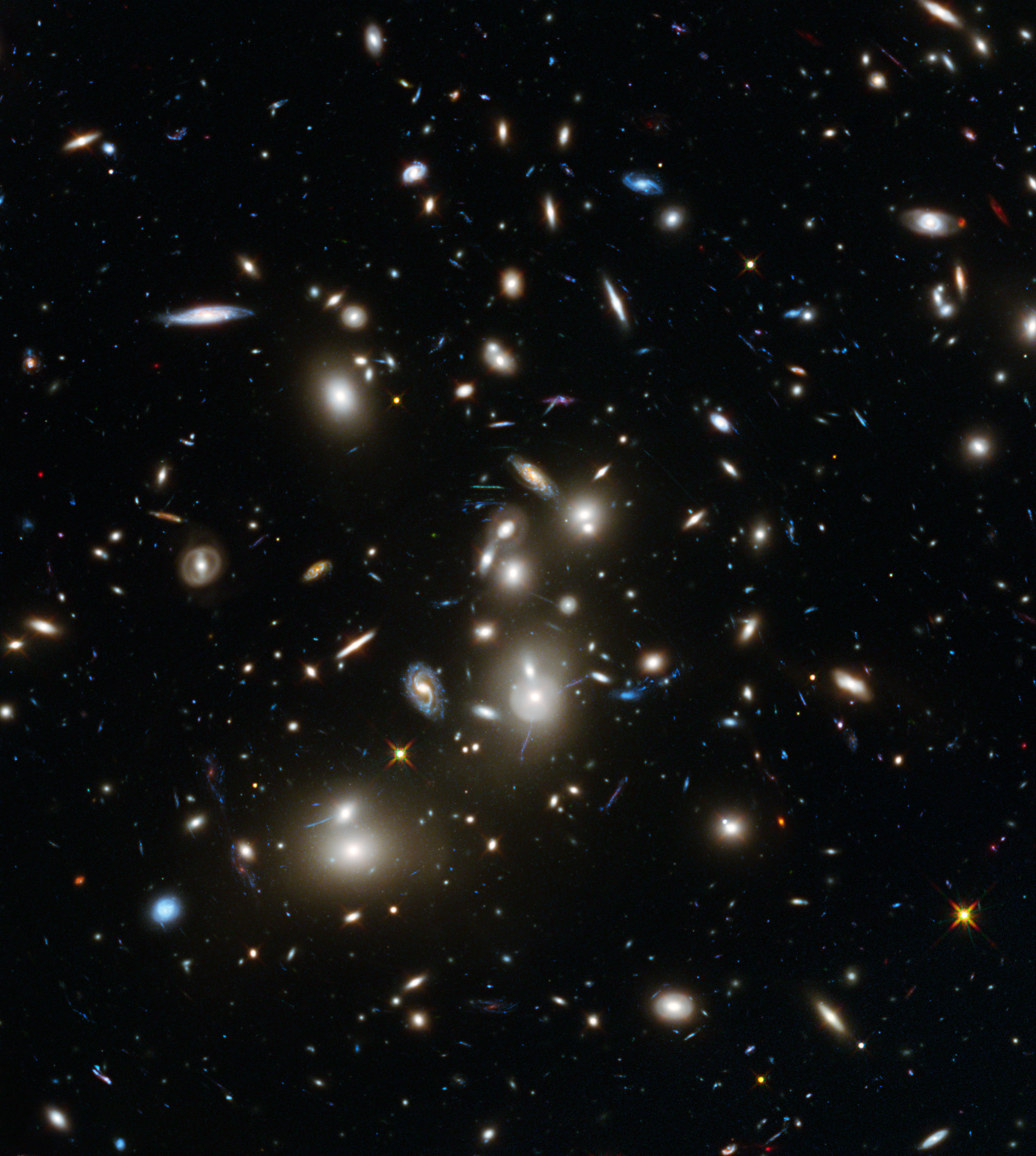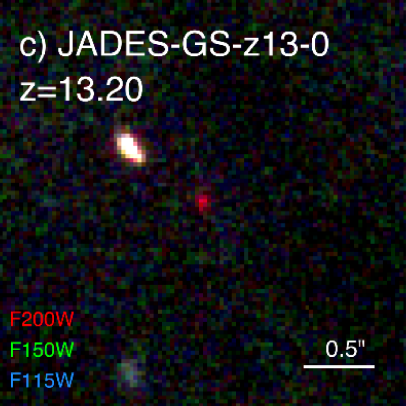|
XMMXCS 2215-1738
XMMXCS 2215-1738 is a galaxy cluster that lies 10 billion light-years away and has a redshift value of z=1.45. It was discovered by the XMM Cluster Survey in 2006.http://www.physorg.com/news68820846.html ''Massive galaxy cluster found 10 billion light years away'' June 6th, 2006, ''Space & Earth'' magazine Discovered in 2006, XMMXCS 2215-1738 is one of the most distant galaxy clusters known. It is embedded in intergalactic gas that has a temperature of 10 million degrees. The estimated mass of the cluster is 500 trillion solar masses, most coming from dark matter. The cluster was discovered and studied using the ''XMM-Newton'' and Keck Telescopes. The cluster is surprisingly large and evolved for a cluster that existed when the universe was only 3 billion years old. Led by University of Sussex researchers, part of the XMM Cluster Survey (XCS) used X-ray Multi Mirror (XMM) Newton satellite to find it, Keck Telescope to determine distance, and used the Hubble Space Telescope to ... [...More Info...] [...Related Items...] OR: [Wikipedia] [Google] [Baidu] |
Aquarius (constellation)
Aquarius is an celestial equator, equatorial constellation of the zodiac, between Capricornus and Pisces (constellation), Pisces. Its name is Latin for "water-carrier" or "cup-carrier", and its old astronomical symbol is (♒︎), a representation of water. Aquarius is one of the oldest of the recognized constellations along the zodiac (the Sun's apparent path). It was one of the 48 constellations listed by the 2nd century astronomer Ptolemy, and it remains one of the 88 modern constellations. It is found in a region often called the Sea (astronomy), Sea due to its profusion of constellations with watery associations such as Cetus the whale, Pisces (constellation), Pisces the fish, and Eridanus (constellation), Eridanus the river. At apparent magnitude 2.9, Beta Aquarii is the brightest star in the constellation. History and mythology Aquarius is identified as "The Great One" in the Babylonian star catalogues and represents the god Ea (god), Ea himself, who is commonly depic ... [...More Info...] [...Related Items...] OR: [Wikipedia] [Google] [Baidu] |
Keck Telescope
The W. M. Keck Observatory is an astronomical observatory with two telescopes at an elevation of 4,145 meters (13,600 ft) near the summit of Mauna Kea in the U.S. state of Hawaii. Both telescopes have aperture primary mirrors, and when completed in 1993 (Keck 1) and 1996 (Keck 2) were the largest astronomical telescopes in the world. They are currently the 3rd and 4th largest. Overview With a concept first proposed in 1977, telescope designers at the University of California, Berkeley (Terry Mast) and Lawrence Berkeley Laboratory (Jerry Nelson) had been developing the technology necessary to build a large, ground-based telescope. With a design in hand, a search for the funding began. In 1985, Howard B. Keck of the W. M. Keck Foundation gave $70 million to fund the construction of the Keck I telescope, which began in September 1985, with first light occurring on 24 November 1990 using nine of the eventual 36 segments. With construction of the first telescope well ... [...More Info...] [...Related Items...] OR: [Wikipedia] [Google] [Baidu] |
List Of Galaxy Clusters
This article lists some galaxy groups and galaxy clusters. Defining the limits of galaxy clusters is imprecise as many clusters are still forming. In particular, clusters close to the Milky Way tend to be classified as galaxy clusters even when they are much smaller than more distant clusters. Clusters exhibiting strong evidence of dark matter Some clusters exhibiting strong evidence of dark matter. Named groups and clusters This is a list of galaxy groups and clusters that are well known by something other than an entry in a catalog or list, or a set of coordinates, or a systematic designation. Clusters Groups The major nearby groups and clusters are generally named after the constellation they lie in. Many groups are named after the leading galaxy in the group. This represents an ad hoc systematic naming system. Groups and clusters visible to the unaided eye The Local Group contains the largest number of visible galaxies with the naked eye. However, it ... [...More Info...] [...Related Items...] OR: [Wikipedia] [Google] [Baidu] |
List Of The Most Distant Astronomical Objects
This article documents the most distant astronomical objects discovered and verified so far, and the time periods in which they were so classified. For comparisons with the light travel distance of the astronomical objects listed below, the age of the universe since the Big Bang is currently estimated as 13.787±0.020 Gyr. Distances to remote objects, other than those in nearby galaxies, are nearly always inferred by measuring the cosmological redshift of their light. By their nature, very distant objects tend to be very faint, and these distance determinations are difficult and subject to errors. An important distinction is whether the distance is determined via spectroscopy or using a photometric redshift technique. The former is generally both more precise and also more reliable, in the sense that photometric redshifts are more prone to being wrong due to confusion with lower redshift sources that may have unusual spectra. For that reason, a spectroscopic redshift is conventio ... [...More Info...] [...Related Items...] OR: [Wikipedia] [Google] [Baidu] |
2XMM J083026+524133
2XMM J083026+524133 (2XMM J0830) is a very large galaxy cluster that lies 7.7 billion light-years away. It was discovered by chance by ESA's XMM Newton and the Large Binocular Telescope (LBT) in Arizona in 2008 while it was looking at the quasar APM 08279+5255. As of 2008, it was the largest known galaxy cluster at red shift z ≧ 1, weighing in at an estimated 1015 solar masses. However, galaxy cluster XMMXCS 2215-1738 is several billion light years farther away. June 6th, 2006, Space & Earth magazine References See also * * |
Hubble Space Telescope
The Hubble Space Telescope (often referred to as HST or Hubble) is a space telescope that was launched into low Earth orbit in 1990 and remains in operation. It was not the first space telescope, but it is one of the largest and most versatile, renowned both as a vital research tool and as a public relations boon for astronomy. The Hubble telescope is named after astronomer Edwin Hubble and is one of NASA's Great Observatories. The Space Telescope Science Institute (STScI) selects Hubble's targets and processes the resulting data, while the Goddard Space Flight Center (GSFC) controls the spacecraft. Hubble features a mirror, and its five main instruments observe in the ultraviolet, visible, and near-infrared regions of the electromagnetic spectrum. Hubble's orbit outside the distortion of Earth's atmosphere allows it to capture extremely high-resolution images with substantially lower background light than ground-based telescopes. It has recorded some of the most detaile ... [...More Info...] [...Related Items...] OR: [Wikipedia] [Google] [Baidu] |
X-ray Multi Mirror
''XMM-Newton'', also known as the High Throughput X-ray Spectroscopy Mission and the X-ray Multi-Mirror Mission, is an X-ray space observatory launched by the European Space Agency in December 1999 on an Ariane 5 rocket. It is the second cornerstone mission of ESA's Horizon 2000 programme. Named after physicist and astronomer Sir Isaac Newton, the spacecraft is tasked with investigating interstellar X-ray sources, performing narrow- and broad-range spectroscopy, and performing the first simultaneous imaging of objects in both X-ray and optical (visible spectrum, visible and ultraviolet) wavelengths. Initially funded for two years, with a ten-year design life, the spacecraft remains in good health and has received repeated mission extensions, most recently in October 2020 and is scheduled to operate until the end of 2022. ESA plans to succeed ''XMM-Newton'' with the Advanced Telescope for High Energy Astrophysics (ATHENA), the second large mission in the Cosmic Vision 2015–2025 p ... [...More Info...] [...Related Items...] OR: [Wikipedia] [Google] [Baidu] |
University Of Sussex
, mottoeng = Be Still and Know , established = , type = Public research university , endowment = £14.4 million (2020) , budget = £319.6 million (2019–20) , chancellor = Sanjeev Bhaskar , vice_chancellor = Sasha Roseneil , head_label = Visitor , head = King Charles III , students = 19,413 (2019–20) , undergrad = 14,619https://www.sussex.ac.uk/webteam/gateway/file.php?name=19-20-digest---undergraduate-student-summary.pdf&site=381 , postgrad = 4,794https://www.sussex.ac.uk/webteam/gateway/file.php?name=19-20-digest---postgraduate-student-summary.pdf&site=381 , city = Falmer, Brighton , state = East Sussex , country = England , campus = Campus , colours = White and Flint , mascot = Badger , affiliations = Universities UK, BUCS, Sepnet, SeNSS, Association of Commonwealth Universities, NCUB , website = , logo = University of Sussex Logo.svg , footnotes = , academic_staff = 2,010 (2020) , administrative_staff = 1,100 The Universit ... [...More Info...] [...Related Items...] OR: [Wikipedia] [Google] [Baidu] |
Universe
The universe is all of space and time and their contents, including planets, stars, galaxies, and all other forms of matter and energy. The Big Bang theory is the prevailing cosmological description of the development of the universe. According to this theory, space and time emerged together ago, and the universe has been expanding ever since the Big Bang. While the spatial size of the entire universe is unknown, it is possible to measure the size of the observable universe, which is approximately 93 billion light-years in diameter at the present day. Some of the earliest cosmological models of the universe were developed by ancient Greek and Indian philosophers and were geocentric, placing Earth at the center. Over the centuries, more precise astronomical observations led Nicolaus Copernicus to develop the heliocentric model with the Sun at the center of the Solar System. In developing the law of universal gravitation, Isaac Newton built upon Copernicus's work as well ... [...More Info...] [...Related Items...] OR: [Wikipedia] [Google] [Baidu] |
XMM-Newton
''XMM-Newton'', also known as the High Throughput X-ray Spectroscopy Mission and the X-ray Multi-Mirror Mission, is an X-ray space observatory launched by the European Space Agency in December 1999 on an Ariane 5 rocket. It is the second cornerstone mission of ESA's Horizon 2000 programme. Named after physicist and astronomer Sir Isaac Newton, the spacecraft is tasked with investigating interstellar X-ray sources, performing narrow- and broad-range spectroscopy, and performing the first simultaneous imaging of objects in both X-ray and optical (visible and ultraviolet) wavelengths. Initially funded for two years, with a ten-year design life, the spacecraft remains in good health and has received repeated mission extensions, most recently in October 2020 and is scheduled to operate until the end of 2022. ESA plans to succeed ''XMM-Newton'' with the Advanced Telescope for High Energy Astrophysics (ATHENA), the second large mission in the Cosmic Vision 2015–2025 plan, to be launche ... [...More Info...] [...Related Items...] OR: [Wikipedia] [Google] [Baidu] |
J2000
In astronomy, an epoch or reference epoch is a instant, moment in time used as a reference point for some time-varying astronomical quantity. It is useful for the celestial coordinates or orbital elements of a Astronomical object, celestial body, as they are subject to Perturbation (astronomy), perturbations and vary with time. These time-varying astronomical quantities might include, for example, the mean longitude or mean anomaly of a body, the node of its orbit relative to a reference plane, the direction of the apogee or Perihelion and aphelion, aphelion of its orbit, or the size of the major axis of its orbit. The main use of astronomical quantities specified in this way is to calculate other relevant parameters of motion, in order to predict future positions and velocities. The applied tools of the disciplines of celestial mechanics or its subfield orbital mechanics (for predicting orbital paths and positions for bodies in motion under the gravitational effects of other bodi ... [...More Info...] [...Related Items...] OR: [Wikipedia] [Google] [Baidu] |
Dark Matter
Dark matter is a hypothetical form of matter thought to account for approximately 85% of the matter in the universe. Dark matter is called "dark" because it does not appear to interact with the electromagnetic field, which means it does not absorb, reflect, or emit electromagnetic radiation and is, therefore, difficult to detect. Various astrophysical observationsincluding gravitational effects which cannot be explained by currently accepted theories of gravity unless more matter is present than can be seenimply dark matter's presence. For this reason, most experts think that dark matter is abundant in the universe and has had a strong influence on its structure and evolution. The primary evidence for dark matter comes from calculations showing that many galaxies would behave quite differently if they did not contain a large amount of unseen matter. Some galaxies would not have formed at all and others would not move as they currently do. Other lines of evidence include observa ... [...More Info...] [...Related Items...] OR: [Wikipedia] [Google] [Baidu] |









